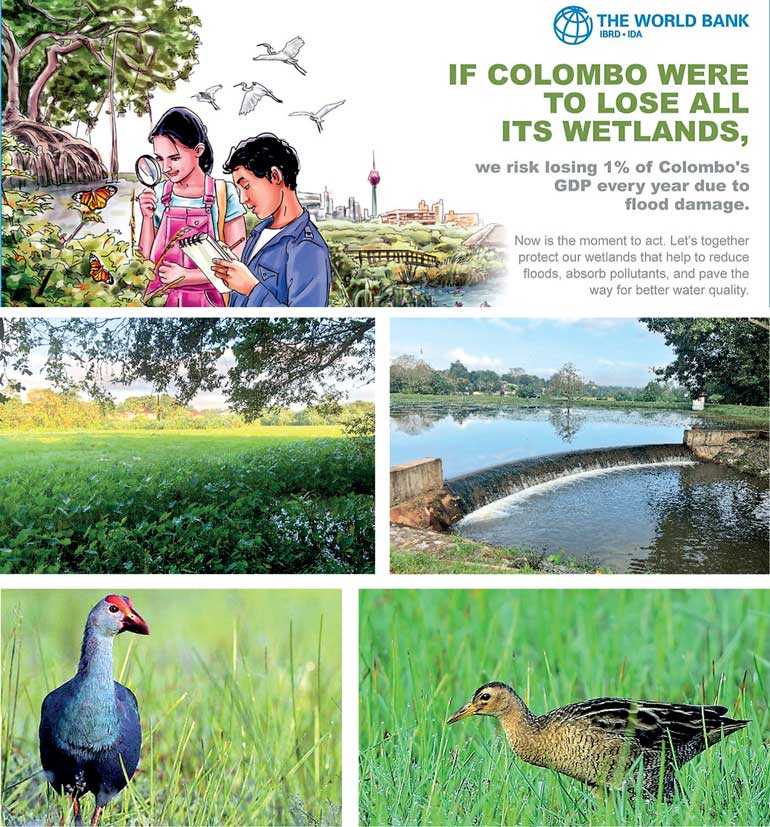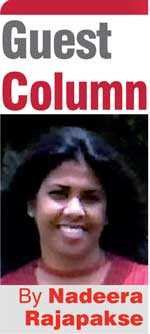Thursday Mar 13, 2025
Thursday Mar 13, 2025
Tuesday, 2 February 2021 00:00 - - {{hitsCtrl.values.hits}}

This article is part of a series of discussions and activities organised by the World Bank South Asia Environment, Natural Resources and Blue Economy team to inform a green recovery in the region
It’s six in the morning and the breaking dawn lights up the wetland before us. The buzz of city sounds has faded away and all we can hear are the alluring melodies of nature’s chorus – a cry of a purple swamp hen and a splash in the water by an elusive wetland creature. These are the sights and sounds residents living around Talangama Lake wake up to each morning. 
Talangama Lake is a perfect example of a multi-use urban wetland that serves multiple interests, which in turn governs its use and management. Steeped in history, the lake is believed to have been built in the 15th century, as a place to bath elephants in the royal army. Now, it is part of the Talangama Environment Protected Area.
For wildlife enthusiasts, it’s a birding haven. For poor farmers, the lake is a source of life that enables paddy cultivation, an ancient practice which dates to the Kotte Kingdom. To the flood managers, the lake retains floodwaters and diverts the excess into the Kelani River to protect Colombo. Further, the wetland supports schools and universities in educational purposes; communities for livelihoods through fishing and lily collection and recreation for visitors who are attracted by the high scenic and aesthetic value.
Colombo is a city built on and around wetlands. Talangama Lake is part of a network of wetlands ecosystems around Colombo city that spreads over 20 sq km and provides critical life support to the city. The wetlands keep people safe from floods, cool the air, filter polluted water, provide food and medicines, fight climate change and provide us, city dwellers, respite from the urban jungle. These wetlands host an array of plants and animals, including the endangered fishing cat and otter.
During the last 30 years an estimated 40% of the wetlands in Colombo has been lost due to direct and indirect impacts of urbanisation. They continue to be lost at an estimated rate of 1.2% per year. If Colombo were to lose all its precious wetlands, the city would be flooded annually costing as much as 1% of its GDP in flood damage.
Although Talangama, like other wetlands, is threatened by the pressures of urbanization, it is heartening to see a sense of community stewardship among its residents who have taken it upon themselves to safeguard the lake and its surroundings.
The World Bank funded Metro Colombo Urban Development (MCUDP) financed the selective partial dredging of the lake in 2017 following extensive stakeholder consultations and scientific study. This work financed by MCUDP set a good practice example of how urban wetlands serving multiple uses can be wisely managed using a transdisciplinary approach. Engineering and environmental sciences were combined with strong stakeholder engagement to strike a balance between irrigation, flood mitigation and wetland conservation goals.
By identifying patches of invasive vegetation while leaving adequate areas undisturbed for wetland inhabitants, the project demonstrated how the wetlands’ capacity to store water and absorb floods could be carried out in an environmentally friendly manner. Two years after lake dredging was completed, avid bird watchers Sanjiv De Silva and Vimukthi Weeratunga who frequent Talangama for birding trips said that wetland avi-fauna has rebounded strongly with a healthy diversity of species being observed.
The MCUDP has been implementing flood mitigation interventions in Colombo since 2012. It has set a benchmark in integrating green and grey infrastructure for flood mitigation in the Sri Lankan capital and demonstrated beyond any doubt that wetlands in Colombo are fundamental to the well-being of its people.
The wetland management strategy, prepared in 2018 by the MCUDP, elucidated the intricate connections between these wetlands and the well-being of the people of Colombo. On virtue of these efforts by MCUDP, in 2018, Colombo was declared the first capital to be accredited as an International Wetland City by Ramsar.
Back at Talangama, we have spotted 22 varieties of birds. Some community members have finished their morning walks, cleaning up the lake and collecting trash. The shallow waters are now awash with open bills and purple swamp hens, their unique blue and green hues glinting in the morning sun, while the lesser whistling teals swim about in the shallow water without a care in the world.
A pair of water cocks are happily moving about in the shallow grass. A pied kingfisher takes to air and dives into the water to catch a meal with almost acrobatic precision. Colombo’s wetlands are indeed a jewel close to home and a key to delivering the city a secure tomorrow! We bid adieu to this beautiful place with the hope of returning soon.
(Nadeera Rajapakse is an Environmental Specialist working with the Environment, Natural Resources and Blue Economy Global Practice at the World Bank. She started working for the Bank in 2004 as a Short Term Consultant and in 2018 joined as staff in the Colombo Office. She works in Sri Lanka and Maldives and focuses specifically on environmental safeguards/standards, landscape planning and conservation, urban wetland management and water resource management.)
Discover Kapruka, the leading online shopping platform in Sri Lanka, where you can conveniently send Gifts and Flowers to your loved ones for any event including Valentine ’s Day. Explore a wide range of popular Shopping Categories on Kapruka, including Toys, Groceries, Electronics, Birthday Cakes, Fruits, Chocolates, Flower Bouquets, Clothing, Watches, Lingerie, Gift Sets and Jewellery. Also if you’re interested in selling with Kapruka, Partner Central by Kapruka is the best solution to start with. Moreover, through Kapruka Global Shop, you can also enjoy the convenience of purchasing products from renowned platforms like Amazon and eBay and have them delivered to Sri Lanka.
Discover Kapruka, the leading online shopping platform in Sri Lanka, where you can conveniently send Gifts and Flowers to your loved ones for any event including Valentine ’s Day. Explore a wide range of popular Shopping Categories on Kapruka, including Toys, Groceries, Electronics, Birthday Cakes, Fruits, Chocolates, Flower Bouquets, Clothing, Watches, Lingerie, Gift Sets and Jewellery. Also if you’re interested in selling with Kapruka, Partner Central by Kapruka is the best solution to start with. Moreover, through Kapruka Global Shop, you can also enjoy the convenience of purchasing products from renowned platforms like Amazon and eBay and have them delivered to Sri Lanka.